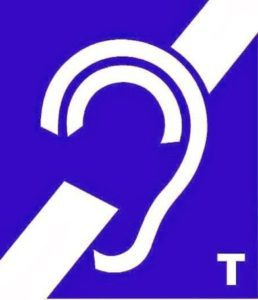Hearing Loops
A hearing loop provides significantly enhanced functionality
for hearing aids and cochlear implants.
*Even with the most up-to-date technology, hearing aids and cochlear implants cannot completely separate important sounds from background noises; nor do they pick up all sounds from a distance such as those in a performance hall, a place of worship or even a home TV viewed from across the room. In such difficult listening settings, hearing (induction) loops are often a solution. A hearing loop is a wire connected to an electronic sound source that transmits that sound to the telecoil in a hearing aid or cochlear implant.
A hearing loop can discreetly surround a room, a chair in your home, or even be worn around the neck. Hearing loops can be connected to a public address system, a living room TV, a telephone (land line and cellular), or any source that produces sound electronically.
*A hearing aid and most cochlear implants equiped with a manually controlled T-switch is needed to hear in a hearing loop. The telecoil, also called t-coil, receives the signal from the loop and turns it back into sound in the hearing aid, often eliminating much of the background noise. The listener then hears only the sounds they desired; whether it is speech from a pulpit, a stage, a telephone conversation, or the television.
*Hearing loops can double hearing aid and cochlear implant functionality. Using the telecoil in conjunction with a hearing loop is a cost-effective way to improve the usability of your hearing aid or cochlear implant. The telecoil can also be used in conjunction with a variety of wireless or hand held hearing assistive listening devices.
Where are hearing loops used?
* Theaters and performing arts centers
* Places of worship
* High school and college auditoriums
* Court rooms and government chambers
*Board rooms and large meeting rooms
* Banquet and sports facilities
* Ticket counters and information booths
* Doctors’ offices and pharmacy counters
* Drive thru and pick up windows
* Elevators, trains and buses
* Museum exhibits
Hearing loops are also helpful in the home by using a neck or small room loop:
* Television or computer
* Telephone or cell phone
* MP3 player, iPod or stereo system
* To find a loop venue look for this sign
Leave a reply
